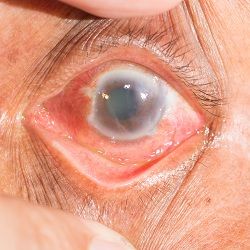Know the hidden links among glaucoma, contact lenses, and the cornea

Halting glaucoma progression can be challenging, but as it turns out, medication is not the only tool in an OD’s toolbox. Many factors influence glaucoma progression in patients, some of which may be unrelated to the disease itself.
ODs must be aware of the hidden links among glaucoma symptoms, medication, and contact lenses with respect to how ocular surface disease (OSD) affects patient outcomes.
Karen Lee, OD, FSLS, FAAO, and Jane Kuo, OD, FAAO, rose awareness to these links at the American Academy of Optometry 2019 meeting in Orlando.
Link Between OSD and Glaucoma
It is known that there is a higher prevalence of OSD in glaucoma patients, primarily related to decreased tear production and break up time. These symptoms may not be related to glaucoma proper, but instead, the medical drops patients use to manage symptoms.
In particular, the benzalkonium chloride (BAK) preservative is a common culprit, present in 70 percent of ophthalmic glaucoma drops. These drops may sometimes produce side effects in patients that may reduce treatment compliance.
“When you have patients with dry eye, it really decreases the quality of life. Anti-glaucoma eye drops containing BAK compromises patient compliance,” Dr. Kuo says.
This molecule disrupts the corneal epithelium by damaging DNA and increasing inflammation. Such a disruption can create particularly challenging concerns when the patient is a contact lens wearer.
Certain contact lenses, particularly hydrogel lenses with high water content, absorb BAK molecules and release them slowly into the corneal epithelium over time. Prolonged exposure to BAK is known to increase symptoms.
Fortunately, ODs can mitigate these corneal/drug interactions through patient education.
“The big idea here is that corneal exposure time to BAK tends to be relatively short-lived,” Dr. Lee says.
The U.S. Food & Drug Administration (FDA) recommends that patients using both glaucoma drops and contact lenses wait at least 15 minutes after instilling drops before applying their lenses. ODs should share this information with their patients to ensure they understand the possible interaction between their contact lenses and their medication.
Additionally, ODs who fit glaucoma patients in contact lenses can work these considerations into their lens selection.
“I might be reaching for a low water content hydrogel soft lens if I know the patient will abuse his drops with contact lens wear,” Dr. Lee says.
Related: Keep an eye on link between glaucoma and blood pressure
Glaucome and postop lens wear
It is common for ODs to encounter patients interested in wearing contact lenses during or after surgical treatments. While there are no contraindications to contact lens wear after procedures like minimally invasive glaucoma surgery (MIGS), ODs need to assess the corneal health of each patient to determine the best approach.
“If the cornea or the sclera is not affected, then patients can potentially keep wearing what they are currently wearing,” Dr. Lee says.
However, if the cornea is affected, ODs will need to consider using gas permeable (GP)s contact lenses that produce a new refractive surface. In these cases, soft contact lenses may not be enough.
“Think about other options. Maybe using scleral topography or some customized lens designs,” Dr. Lee says.
Corneal procedures and glaucoma
Glaucoma can cause corneal challenges, but what about corneal procedures that make glaucoma worse?
“As the techniques are getting more and more advanced, we are starting to see more partial thickness procedures,” Dr. Lee says.
While the link between corneal refractive surgery and intraocular spikes in pressure are not well understood, it is clear that such procedures can change the biomechanics of the cornea. For some patients with high refractive errors, this can produce a predisposition for glaucoma.
But new procedures are on the horizon, such as corneal cross-linking that can slow down or even halt progression of keratoconus without undoing corneal changes.
“We are really recommending our keratoconus patients go out and get this done,” Dr. Lee says.
However, changes to the physiology of the cornea may be unavoidable in some procedures, and ODs must be aware of these concerns before recommending a procedure.
“If your patient had glaucoma before a transplant, there is a 12-15 percent risk of glaucoma worsening afterward,” Dr. Lee says.
ODs must monitor and continue treating patients after invasive procedures, particularly helping patients manage their intraocular pressure (IOP) by testing via temporal sclera, Tono-Pen (Reichert), or globe palpation. This preventative care is a necessary part of managing patient symptoms and delivering a high standard of care.
“Try to get patients the best vision that you can in a healthy way,” Dr. Lee says.
More from Greg Hill and Marek Biernacinski
Newsletter
Want more insights like this? Subscribe to Optometry Times and get clinical pearls and practice tips delivered straight to your inbox.
2 Commerce Drive
Cranbury, NJ 08512
All rights reserved.